Recent Articles
Popular Makes
Body Types
2020 Audi R8 Spyder Road Test and Review
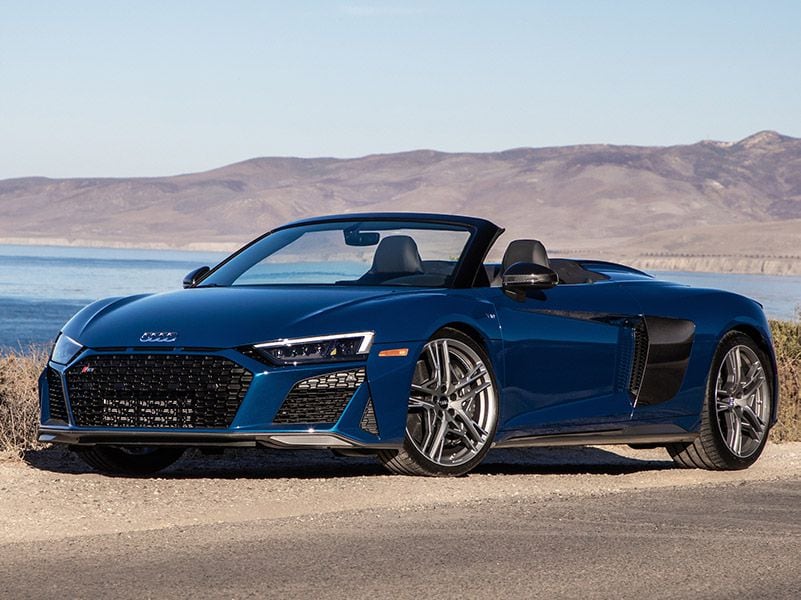
2020 Audi R8 Spyder hero ・ Photo by Audi
There’s always a lot of talk about “everyday supercars” — mid-engine, high-performance machines that can be driven daily. These are big-horsepower 200-mph exotics that can get you to work reliably and comfortably. They were once a myth, a fantasy, but over the last 30 years, they’ve become a reality. The 2020 Audi R8 Spyder is one of the best.
Originally introduced in 2008, the Audi R8 is now deep in its second generation and remains the German luxury brand’s only mid-engine machine. The two-seater has always been offered as a coupe or as a convertible called the Spyder, like our test car, and it was one of the first supercars to offer all-wheel drive. This year, the 2020 Audi R8 Spyder has received significant improvements to its exterior styling and performance. It’s not only more powerful than before, but Audi has also improved its handling. Rivals include the Ferrari F8 Spider, Lamborghini Huracan Evo Spyder, BMW i8 hybrid roadster, several droptop McLarens, and the new 2020 Chevrolet Corvette convertible.
Two Models to Choose From
Audi R8 Spyder ownership remains an exclusive club. Prices start at $185,050, including a $1,700 gas-guzzler tax and a $1,250 destination charge, and Audi only sells about 500 a year. All-wheel drive remains standard, and every 2020 R8 is powered by an all-aluminum V10 engine backed by a seven-speed dual-clutch automatic transmission, but there are two models to choose from: the base V10 and the more powerful Performance, like our test car.
The R8 Spyder Performance has a base price of $211,050. Standard equipment includes a chassis made of aluminum and carbon fiber, massive carbon fiber brakes, 20-inch forged aluminum wheels with ultra-wide high-performance Michelin tires, and a power soft top that conceals itself under a hard boot in about 10 seconds. With options like its stunning Ascari Blue paint job, a Sport Seat Package with diamond stitching, a Bang and Olufsen sound system, and Audi’s Dynamic Steering system, our test car cost $219,145.
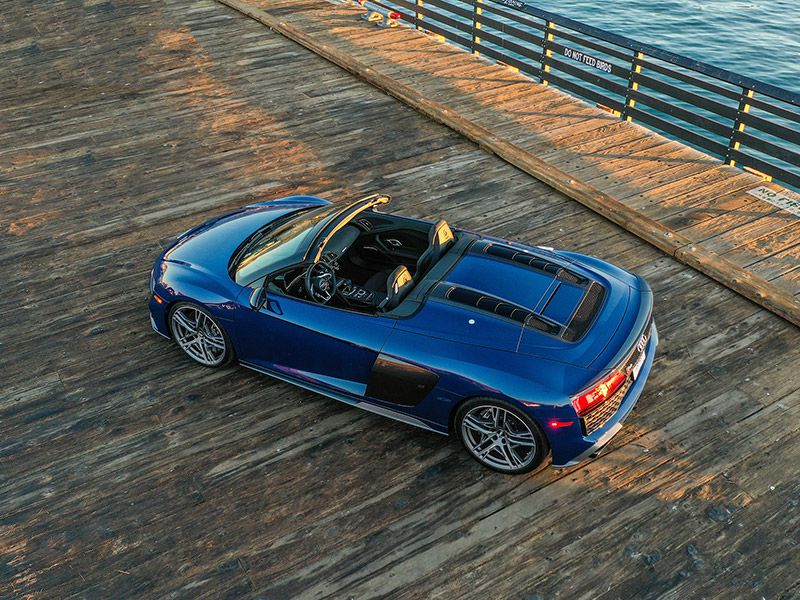
Photo by Audi
Similar to a Lamborghini Huracan
The 2020 Audi R8 Spyder is a product of the global auto industry. Because Audi and Italian brand Lamborghini are both owned by Volkswagen, it shares many components with the 2020 Lamborghini Huracan EVO Spyder. The two mid-engine supercars use the same chassis, V10 engine (which is assembled in Hungary), seven-speed dual-clutch automatic transmission, all-wheel drive, and suspension system. But the two are far from twins, as there are significant differences between the two.
Lambo builds the Evo in Sant’Agata Bolognese, Italy, while the R8 is built in a mega factory in Heilbronn, Germany, with a long list of other Audi models. The Audi’s sexy skin is also more conservative than the Italian’s, its wheelbase is 2.4-inch longer, and its interior is much more friendly for everyday use. The R8 is also downright cheap compared to the Lamborghini Huracan EVO Spyder, which has a base price of over $287,000.
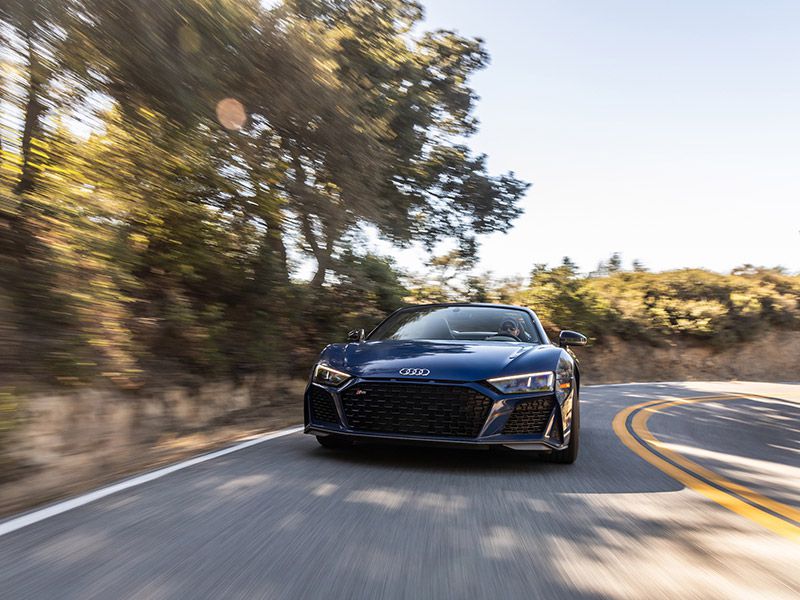
Photo by Audi
602 Horsepower Without Turbos
Producing awesome power and a howling exhaust note at its stratospheric 8,500 rpm redline, Audi’s large-displacement V10 is one of our favorite engines. But it isn’t exactly state-of-the-art. These days, most big-buck supercars feature engines with twin turbochargers, but the R8’s 5.2-liter remains naturally aspirated.
This year, the base V10 model packs 562 horsepower, an increase of 30 hp. Audi says the Spyder — which weighs about 280 lbs more the coupe — can hit 60 mph in 3.5 seconds, a blink behind the lighter hardtop, and ultimately reach 200 mph. The R8 Performance is even more extreme. It isn’t only more powerful, delivering 602 hp and 413 lb-ft of torque, but it’s louder too thanks to a standard adjustable sport exhaust system that’s exclusive to U.S. models. The cars sold in Europe are quieter. Use the launch-control feature, which allows you to rev the engine to 4,500 rpm before releasing the brake pedal, and it slams you back in the seat and holds you there. According to Audi, the Spyder Performance hits 60 mph in just 3.3 seconds and has a top speed of 204 mph.
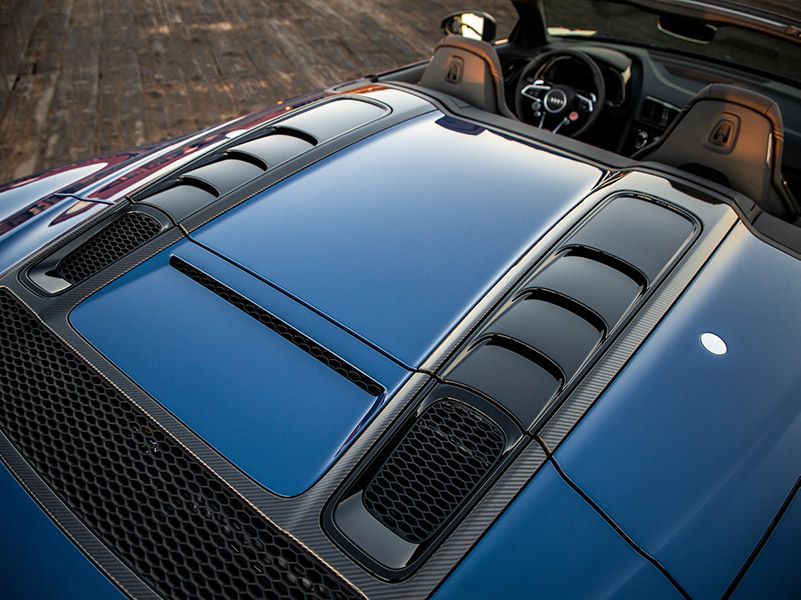
Photo by Audi
Spectacular Transmission
Every 2020 Audi R8 Spyder is equipped with a dual-clutch seven-speed automatic transmission. However, the gearbox is retuned in the Performance models with more aggressive gear ratios for quicker response around town and harder acceleration. When you’re feeling lazy, the transmission features a fully automatic mode, but it’s more fun to select gears yourself with its paddle shifters mounted to its steering wheel.
The Audi engineers who tuned this transmission did it right. At full throttle, it keeps the Audi’s V10 above 6,000 rpm, where it makes the majority of its power. Gearchanges are lightning-quick, especially in Performance mode, which is selected with a button on the steering wheel. Because the engine revs so rapidly that it can be hard to keep up, the transmission upshifts second gear for you, offering true manual operation only after that. On the highway at 80 mph, the shorter top gear keeps the V10 at a high 3,250 rpm, which isn’t exactly great for fuel economy, but it’s low enough to keep noise from being an issue.
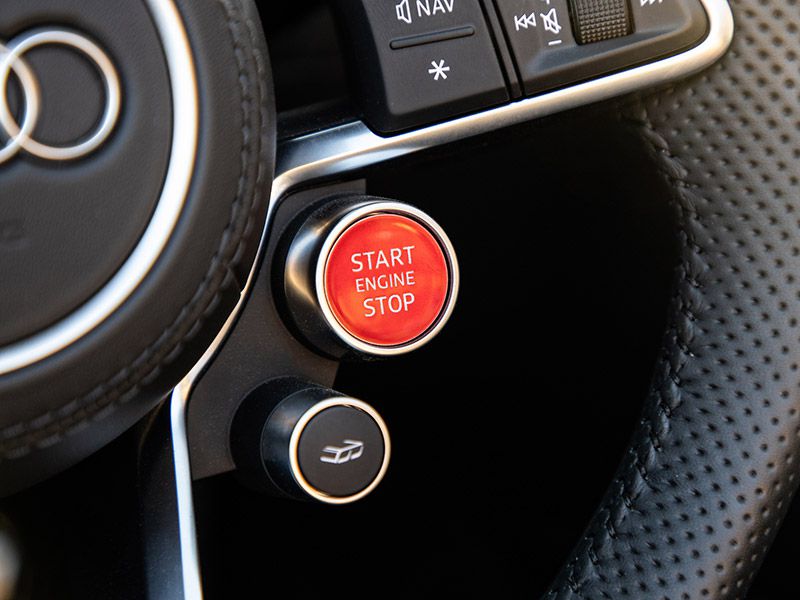
Photo by Audi
Improved Handling and Steering Feel
This year, Audi has also improved the R8’s handling. To improve grip, it has switched all R8s from Pirelli PZeros to Michelin Pilot Sport 4 S tires. Plus, it has retuned its front suspension with stiffer bushings and has given the steering system a bit more weight and feel.
Unlike the Lamborghini Huracan, the R8 does not have a rear-wheel steering system, but its all-wheel drive does have a mechanical limited-slip rear differential. Although the system can send up to 100 percent of the V10’s power to the front or rear tires to maximize traction and performance, in Dynamic mode, it makes every effort to keep more power going to the rear axles for a sportier rear-wheel drive feel. The supercar is incredibly fast on a twisty two-lane, but more importantly, its handling is stable and secure. Unlike some supercars that feel like they want to kill you, the all-wheel drive R8 isn’t twitchy; it’s fast but forgiving, which makes the experience less stressful and more fun. Its massive cross-drilled carbon ceramic brakes are also some of the best in the world.
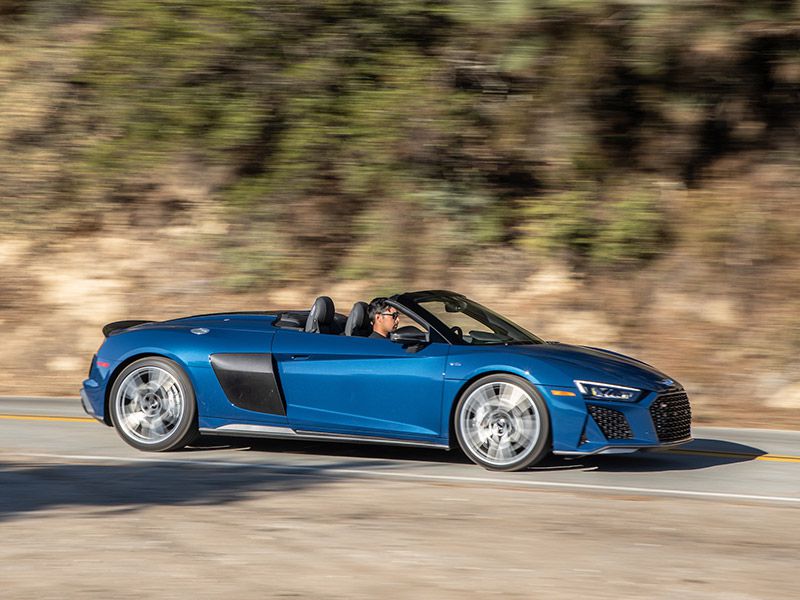
Photo by Audi
Smooth Ride for a Supercar
If you’re looking for the smoothest-riding R8 Spyder, stick with the base V10 model. It gets an adjustable suspension with magnetic shocks, and its suspension is tuned a bit softer than the fixed suspension of the Performance model. It also rides on smaller 19-inch wheels and tires.
On its standard 20-inch wheels and tires, our Performance Spyder test car rode firmly, but it was extremely comfortable by supercar standards. Unless you live on a dirt road, it’s undoubtedly compliant enough for every day driving. The suspension of the Lamborghini Huracan Evo Spyder is tuned far more aggressively, though the new Chevrolet Corvette Stingray and the McLaren 720S do ride more smoothly.
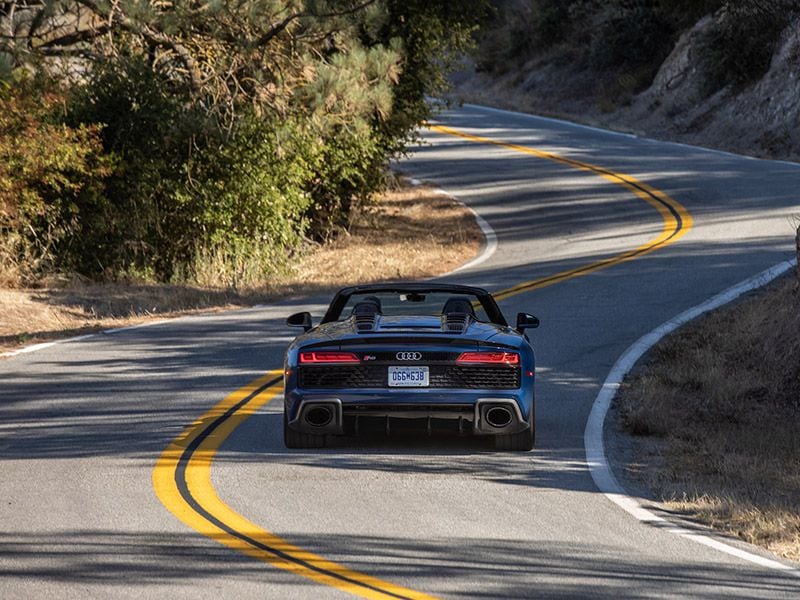
Photo by Audi
Subtle Styling Updates Add Some Intensity
Some say the R8 is styled too conservatively for a supercar, which is just crazy. Instead, the Audi proves a supercar can be beautiful and turn heads without being obnoxious. This year Audi updated its look, but the changes aren’t radical. The new, more angular front end features a wider honeycomb grille and sharp upright elements next to darkened headlamps. The rear bumper has also been reshaped with honeycomb air outlets, a beefier rear diffuser, and two massive oval exhaust pipes.
Its redesigned rocker panels now include a gloss black inlay on the base V10 model and a strip of titanium on the Performance. If you’d prefer a strip of carbon fiber, it’s optional. There are also new wheel designs with more complex angular patterns. Overall the R8 Spyder’s new look is more intense than before, and it’s striking from every angle, especially with its top folded away.
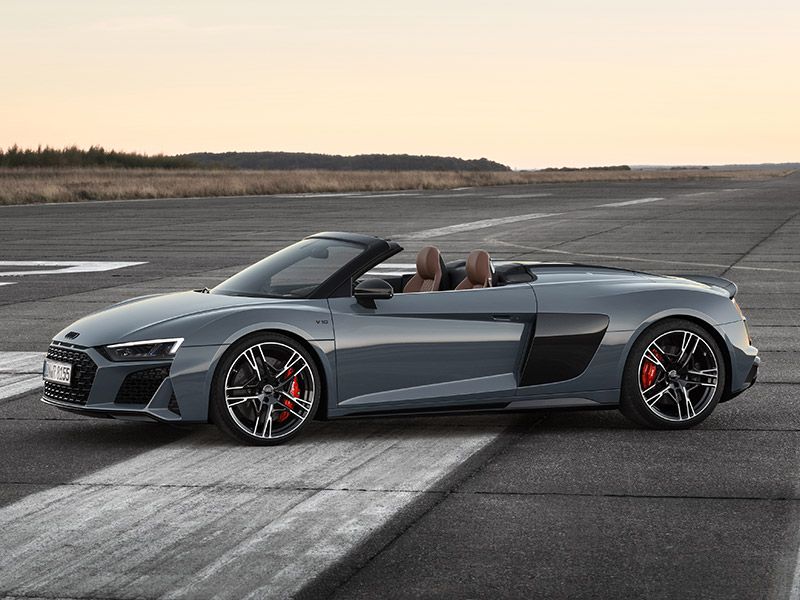
Photo by Audi
Comfortable Interior for a Supercar
There’s more room inside this supercar than you may expect, and the R8’s interior is as luxurious as they get in this class. Instead of rocklike racing seats and off-the-wall ergonomics, you’re met with heated well-bolstered buckets. They’re firm, but they aren’t hard, so they’re comfortable even after hours behind the wheel. Wind control with the top down is also very good thanks to a rear window that doubles as a wind blocker.
Unlike the interior of all other Audis, the R8’s dashboard doesn’t feature a screen for its infotainment system. Instead, its audio system information and navigation maps are seen ahead of the driver on the configurable instrument cluster, which also features simple digital gauges with a center-mounted tachometer. The cabin does include a load of carbon fiber trim, uncomplicated audio controls, and a thick leather-wrapped flat-bottom wheel with a big red engine-start button. There are also two cupholders and plenty of storage, which is rare in this class.
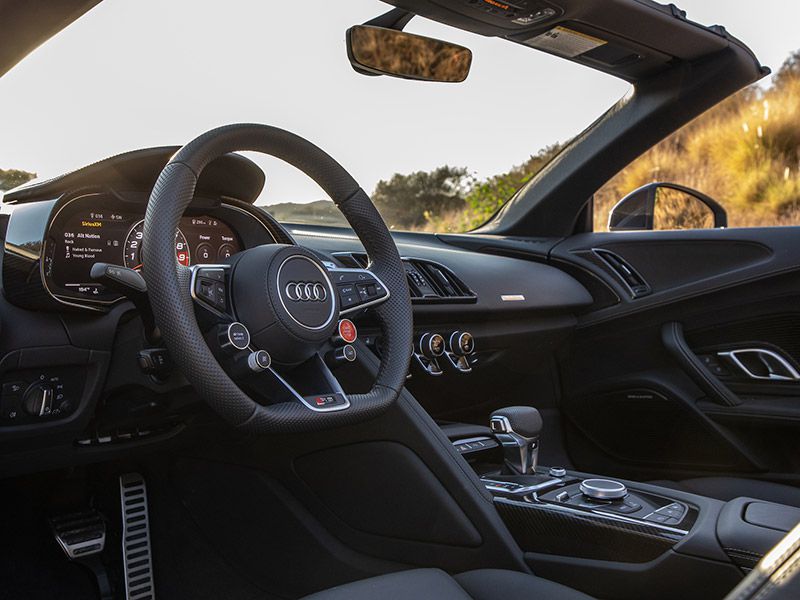
Photo by Audi
Final Thoughts
There are a few issues with the R8 we haven’t mentioned — small things that we think Audi can improve. Surprisingly, it doesn’t have dual-zone climate control, which won’t make some passengers happy. Audi should also show off the supercar’s beautiful engine; the Spyder’s hood doesn’t open like the coupe’s. Ventilated seats would also be nice.
Still, even as it is, the 2020 Audi R8 Spyder is one of our favorite cars. Any supercar can go fast, but the R8 is also sophisticated and refined, quiet, and comfortable. If you’re in the market for an exotic mid-engine convertible, an open-top supercar you can really enjoy every day, it’s an exceptional choice.
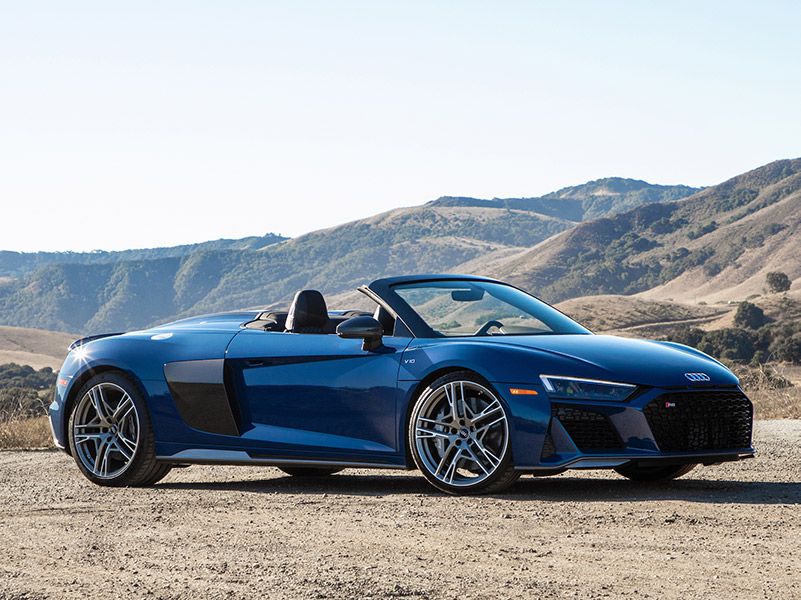
Photo by Audi